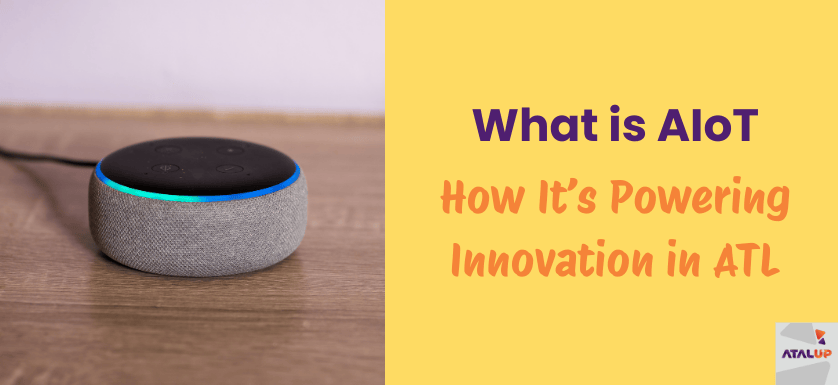
Imagine a dustbin that knows when it’s full… and actually tells you! Or a classroom fan that turns off automatically when no one’s around. Sounds futuristic? Not anymore. Thanks to AIoT – Artificial Intelligence of Things, even school kids can now build such smart systems inside their Atal Tinkering Labs.
AIoT isn’t just about high-tech stuff. It’s about helping students solve real-world problems using a mix of Artificial Intelligence (AI) and Internet of Things (IoT). In this blog, let’s understand ‘what is AIoT’, how it works, some everyday examples, and how schools can use it to make learning more exciting and meaningful.
What is AIoT? (Artificial Intelligence of Things)
Let’s break it down.
IoT (Internet of Things) is about connecting devices to the internet so they can send or receive data like a fitness band tracking your steps and sending it to your phone.
AI (Artificial Intelligence) is about making machines smart. It’s what helps Google predict what you’re about to type or how YouTube recommends videos.
AIoT = AI + IoT. The devices not only collect data but also understand it and act accordingly.
So, when a sensor senses and the system thinks before reacting, that’s AIoT in action. Think of AIoT as a brain + nerves + hands combo.
IoT = senses + hands
AI = brain
AIoT = all working together!
Examples of AIoT in Real Life
Here are some relatable examples you probably come across often — without even realizing they’re powered by AIoT:
1. Smart Home Assistants (like Alexa or Google Nest)
They listen to your voice (IoT), understand commands (AI), and turn off the lights, play music, or set alarms.
2. Face Recognition Attendance
Cameras (IoT) capture faces, and AI algorithms recognize who it is. No need to call out names. Great for schools and offices.
3. Wearable Health Devices
Smartwatches track your heart rate, sleep, and steps, and even alert you when something’s wrong. The data is sensed (IoT) and then analyzed (AI).
4. Smart Agriculture Tools
Farmers use soil sensors and weather data (IoT) combined with AI to decide the best time for watering crops or applying fertilizers.
These are just a few of the growing examples of AIoT transforming our daily lives.
Difference Between IoT and AI
Here’s a simple table to clear the confusion between the two:
| Feature | IoT (Internet of Things) | AI (Artificial Intelligence) |
| Purpose | Connects devices to exchange data | Makes systems capable of learning and decision-making |
| Role | Senses and transmits information | Analyzes and interprets information |
| Example | Temperature sensor in a room | AI predicts when the room will need cooling |
| Dependency | Needs network & sensors | Needs data to train and improve |
| Output | Raw data or action based on sensor | Intelligent decision-making based on patterns |
| When Clubed | Smart decisions using both sensing and intelligence | Like an auto-switching fan that knows room temperature + usage |
How Can AIoT Integration Enhance Learning in Classrooms?
Now let’s talk about the fun part; how students can use AIoT in Atal Tinkering Labs.
Schools across India are using AIoT to shift from textbook learning to real innovation. Instead of just reading about “how sensors work,” students build smart models that respond to real-world problems.
Here are some ways AIoT can level up learning:
Build Smart Prototypes
From pollution detectors to voice-controlled lights, students learn by doing. They use Arduino or Raspberry Pi, add sensors, connect cloud services, and create intelligent products. It’s tech + creativity in action.
Learn Real Data Analysis
When students collect data using IoT (say temperature or humidity) and then apply AI models to predict trends, they understand how data science works practically.
Develop Logical Thinking
AIoT projects require coding, logic-building, testing, and iteration. Students learn how to break problems, think critically, and improve constantly, skills needed for the real world.
Collaborate on Social Impact Projects
ATL encourages solving local problems. For example, a student team may design a water-saving device for their village using sensors + AI logic. That’s meaningful innovation.
The AIoT Integration Book by AIM even includes step-by-step projects and case studies for ATL labs. It’s a goldmine for teachers and students alike.
How ATALUP Supports AIoT Integration
Setting up AIoT learning isn’t easy for every school. That’s where ATALUP steps in as a complete ATL lifecycle partner.
Here’s how ATALUP makes AIoT integration smooth:
Teacher Training
Not every school has tech experts. ATALUP trains teachers to guide students through AIoT projects confidently.
Project Frameworks
Schools get structured guidance, from idea to final submission. Students aren’t lost midway.
Compliance + Tracking
ATALUP helps schools maintain compliance, measure ATL effectiveness, and document innovation for grants or CSR partnerships.
In short, ATALUP is an ATL success partner, especially when you want to go beyond just setting up labs and actually building innovation on the ground.
Conclusion
What is AIoT? AIoT is the future, and the future is already here. Artificial Intelligence of Things is no longer “next-gen”; it’s happening now. And schools have a big role in preparing young minds for this smart future. By integrating AIoT into the ATL curriculum, we’re not just teaching students how machines work, we’re showing them how to think, solve, and innovate.
So, the next time a student says, “Let’s build a smart bell that senses if someone’s at the door and speaks out their name,” smile. That’s AIoT. And that’s where real learning begins.